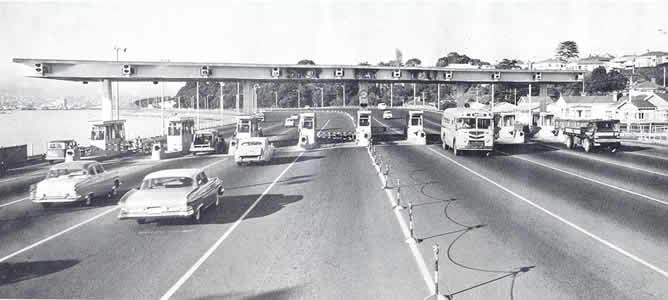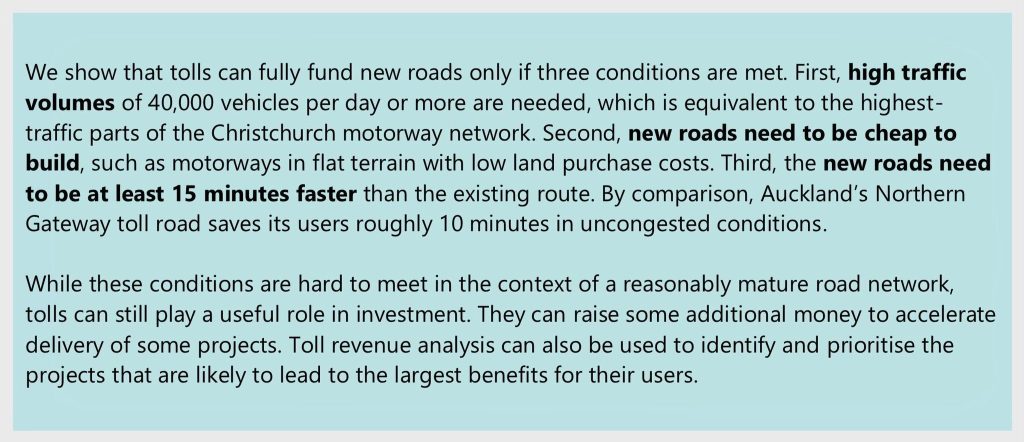Money from transport, money for transport
Here’s another banger of a Te Waihanga report, this time on ways fund transport projects. It’s quite arresting…
With a government (rightly) thinking more laterally about how to fund infrastructure, there’s lots of talk about funding things with tolls. Some of it is really hot talk, like a suggestion that despite a long tunnel under Te Aro being genuinely bonkers, * tolling could make it viable [*warning: the latter hyperlink is a very disreputable channel so watch out for the Youtube algorithm noticing]).
[Sidebar: Funnily enough, congestion charging is getting less enthusiasm from folks who like to build big things, despite being enabled by lots of the same infrastructure as (modern) tolling. This is because congestion charging involves using some tech (expensive, but nowhere near big-civil-engineering-project expensive) to help nudge people’s driving behaviour so we can get more value of the road space we already have, rather than enabling lots of big new projects. (Just no fun at all, when you wanna build big new projects.)]
So it’s a perfect time for some cool-eyed perspective on tolling in particular – a really important way to fund infrastructure.
Here’s the report [2MB PDF], and some great context about the role of transport pricing and water pricing in making a sustainable infrastructure landscape.
In the report itself, if you want a TL;DR, the “Key Findings” alone are pretty potent. They’re handily sitting on Te Waihanga’s website as well as being in the PDF.

There it is, in plain unequivocal language. Induced demand. Said once more for those in the back… and for many of those in high places.

In other words: if tolling won’t cover the costs, and you’re determined to build anyway, you’re taking money from somewhere else.
If that elsewhere is public money, are we really up for the opportunity cost of a big new road that’s not adding enough to people’s lives to make a toll worthwhile? That opportunity cost is taking money from public transport, road repair, road resilience, walking/cycling/scooting – and that’s just if we only funded transport stuff from the (hugely-oversubscribed) National Land Transport Fund (haha as if). So, money would also be taken from things like hospital care, upkeep of our frigates, kids’ learning…

“We already have a mature road network with relatively few ‘missing links'”.
In other words, it’s really hard to find a brand new road that’s adding that much value anymore. We’ve focussed so much on road-building for the last 60+ years (including many, many roads whose money-gobbling life is a foregone conclusion thanks to surrounding landuse that’s too thin), that there simply aren’t Major Gaps Out There that people are desperate for.
Compare with (for example) the Auckland Harbour Bridge, which was so crucial a missing link with such high value to people, that even with the much much smaller population and less car ownership, it was fully paid for over just a few decades by tolls[teeny PDF].

Plus with construction costs the way they are, especially if we want to build roads in our “non built-on” land which is damn hilly and therefore crazy expensive to road-build in (yes looking at you Petone to Grenada), we’re looking for a unicorn if we want tolls to cover any new roads.

Can we please just stop pretending there’s lots of brand-new roading projects where a toll will make a major contribution to the funding bucket? They can help, sure – in the ways Te Waihanga outlines. But let’s not get carried away and start thinking tolls could significantly fund marginal additions to a network (let alone daft things like a long tunnel under central Wellington).
Just read the report, it’s worth it
In fact it’s worth diving into all the sections that unpack what’s summarised in the Key Findings. It’s a beautifully written report – really well explained, great visuals, and will give you a whole brace of fun facts to drop into the next conversation when someone says to you “ah those big new motorways will be awesome, we can just set them all up as toll roads, easy peasy!”
It didn’t get explicit callout in the Key Findings, but it’s definitely worth reading the report’s nice explanation of the contribution that congestion charging makes – from p32. Highly recommmended as companion reading: Te Ara Matatika – the Fair Path on equitable ways to use congestion charging.
Finally, for a glimpse into what might have been, check out this fascinating look into “Better Transport, Better Roads” – a 1990s reform project which, while imperfect, would’ve helped prevent a lot of today’s SNAFU… but was scuppered by the incoming Labour government in 1998:
I
Leave a comment